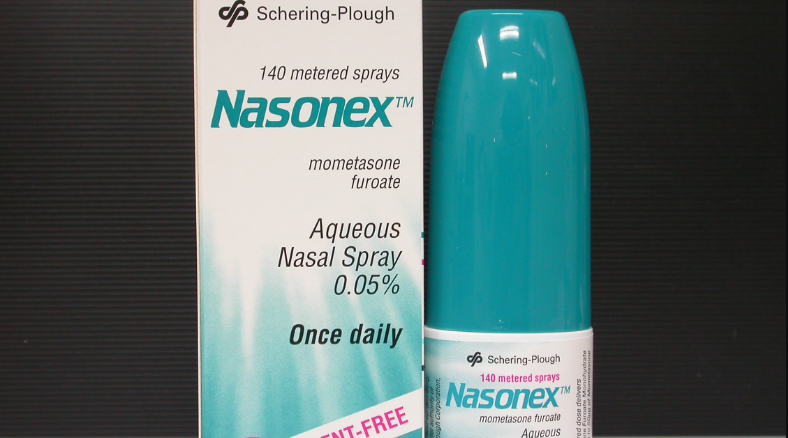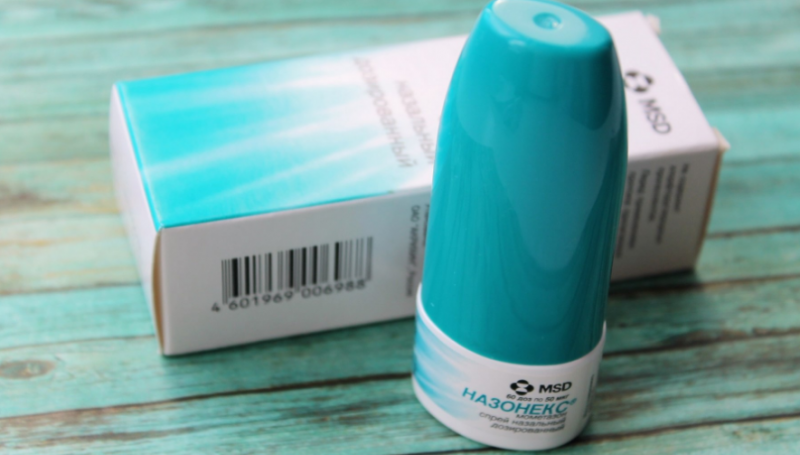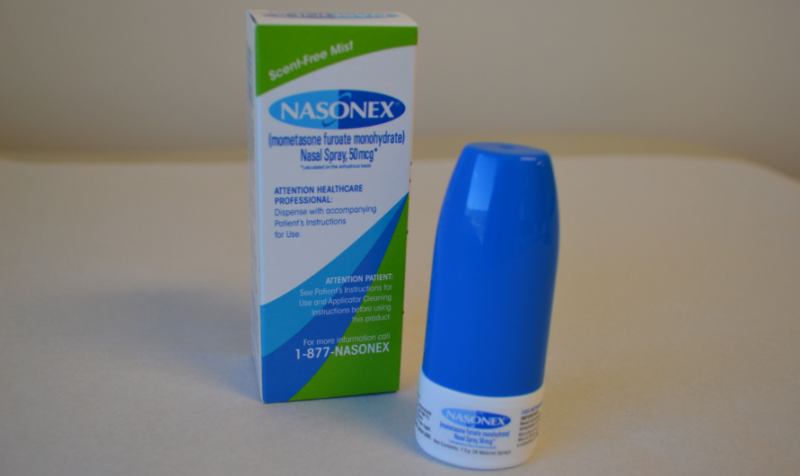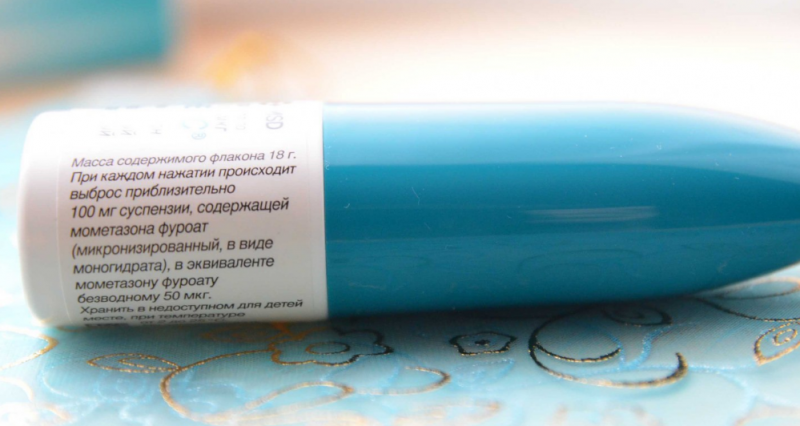The drug relieves itching in the nose, saves from congestion and profuse runny nose, makes it possible to breathe freely. This is how Nazonex spray is described by people suffering from hay fever, allergic rhinitis and sinusitis. Many will be interested to know that there are cheaper analogues than this Belgian remedy.
Material Content:
General description and composition of the drug
Spray for intranasal administration is released in a plastic bottle with a micropump. The device is mounted in the nozzle, equipped with a valve that facilitates the dosing of funds. "Nazonex" released in Belgium. Generics under other brand names are produced in India.
The “Nazonex” contains only one active substance (DV) - mometasone furoate in the form of a monohydrate. This prodrug in the body breaks down with the release of the mometasone glucocorticosteroid. The abbreviation GCS is often used to abbreviate the name of the entire group of drugs.
A practically insoluble prodrug forms a suspension with purified water and alcohols. The concentration of DV in 1 dose is the same, is 50 μg. Vials are produced with 120 and 60 doses.
Pharmacological properties
Mometasone has a local, fairly strong anti-inflammatory and anti-allergic effect on the nasal mucosa. The therapeutic effects of the drug are due to the binding of DV to glucocorticoid receptors. As a result, swelling decreases, inflammation of the nasal passages passes.
Nasonex relieves the symptoms of allergies, sinusitis, and hay fever (allergic rhinitis with conjunctivitis). Itching in the nasopharynx, sneezing, profuse runny nose. Improvement is noted after 3-4 hours.
The instructions for use indicate that the maximum therapeutic effect usually develops 12 to 48 hours after using the spray.
For which diseases is indicated "Nazonex":
- acute or chronic allergic rhinitis in children from preschool age and adults;
- acute rhinosinusitis and sinusitis in patients over 12 years old;
- polyposis of the nasal cavity in adults from 18 years.
The functions of the nasal mucosa are significantly impaired with inflammation. "Nazonex" eliminates edema, reduces congestion, improves breathing through the nose and smell. The drug helps to alleviate the symptoms of bronchial asthma, often associated with allergic rhinosinusitis.
With topical application of the drug, atrophy of the nasal mucosa does not occur. In clinical practice, there were no cases of the development of drug resistance to DV if the drug was used for less than 12 months.
Instructions for use and dosage regimen spray Nazonex
First, a "calibration" is carried out for the same supply of DV with each "zilch". The bottle is shaken vigorously, remove the dust cap. The thumb is placed at the bottom of the bottle, the index and middle fingers are pressed 7-10 times on the nozzle plane near the hole. This regulation should be repeated every two weeks.
One injection is one dose of mometasone furoate.
With daily use, only shake the bottle, remove the lid, direct the hole in one nasal passage and press. A suspension is ejected from the hole. Press the nostril with the finger of the other hand to the nasal septum and inject the medicine into the other nasal passage. The bottle is kept upright all the time.
For children
Treatment of babies with Nazonex is allowed from the age of two. The drug is prescribed for children from 2 to 11 years. Indications for use in pediatrics: allergic rhinitis, exacerbation of sinusitis, adenoids (as part of complex therapy).
"Nazonex" for children is released with a content of DV of 50 mcg. Kids do not know how to make inhalations themselves, adults help them. A schoolboy can independently spray a spray into his nose. Children under 12 years of age need only one inhalation per day.
It is necessary to gradually reduce the dose, reduce the course of treatment. GCS with systemic and local application can slow the growth of children. You can not independently increase the number of applications of Nazonex, exceed the recommended dosage.
For adults
Treatment of seasonal allergic diseases of the respiratory tract is recommended to be started in advance. Apply "Nazonex" already 2 to 4 weeks before the flowering of the allergenic plant and the entire period of dusting.
How to use a spray:
- Injected 2 times in each nasal passage once a day.
- If symptoms persist, then you can "zip" spray 4 times in each nostril once.
- After subsiding of the manifestations of the disease, the daily dose is reduced to 1 injection in each nasal passage.
Inhalations should be performed at the same time.
The action of GCS is manifested on the first day. However, the maximum effect may be delayed for several days. In some cases, patients notice improvement after only a couple of weeks.
"Nazonex" is suitable for prolonged use, unlike antihistamines.
Sinusitis is treated by spraying 2 times in each nostril. In case of exacerbation of the disease, it is sufficient to use "Nazonex" once a day. If the effect is weak, then increase the dose to 4 inhalations in each nasal passage. Apply the tool in the morning and evening. "Nasonex" is indicated for uncomplicated acute rhinosinusitis for symptomatic treatment. GCS should not be used for complications of a bacterial infection.
Spray is used to treat nasal polyposis in people over 18 years of age.The daily dose is 2 injections into each nostril in the morning and evening. After symptom improvement, inhalation is carried out only once a day. Every 14 days, clean the sprayer and dust cap.
Pregnancy and lactation
Glucocorticoids are not commonly used to treat women in position and breastfeeding. The doctor may prescribe Nasonex to the patient during pregnancy, carefully weighing the pros and cons. It is necessary that the expected benefit outweighs the possible risk to the fetus or child.
Interaction with other drugs
It is precisely known that the hormonal nasal spray with mometasone mutually enhances the effect of the antihistamine loratadine. The combination with other drugs has not been investigated. It is possible to enhance the effect with simultaneous therapy with other corticosteroids. Mometazone furoate is metabolized in the liver. Ketoconazole may increase the concentration of this GCS in plasma.
Contraindications, side effects and overdose
Nasonex Nasal Spray is not used:
- with allergies to DV;
- with hypersensitivity to excipients in the composition of the drug;
- fungal, bacterial and viral infections are also contraindications;
Nasonex is not recommended for use in pulmonary tuberculosis, wounds and ulcers of the nasal cavity before healing.
The nasal spray is better tolerated, compared with systemic corticosteroids, causes much fewer side effects. However, nosebleeds, sneezing, irritation, burning, inflammation of the nasopharynx, headache may occur.
The most significant side effect of Nazonex is mucosal atrophy after 12 months of continuous treatment.
An overdose is dangerous because the systemic effect of the nasal agent is enhanced, including the negative effect of GCS on the growth of children. In some cases, there is an increase in intraocular pressure, blurred vision.
Analogs of nasal spray
Local treatment of corticosteroids helps get rid of the symptoms of allergic rhinitis and nasal polyposis. If the causes of the disease and the action of the stimulus persist, then exacerbations will follow in the future.
Full analogues of "Nazonex":
- Momat Rino
- "Nosephrine";
- "Desrinitis";
- "Mometasone Sandoz."
Beclomethasone in the form of a spray also helps with allergic rhinitis. Trade names of the preparations: Nasobek, Beklazon. Spray and aerosol are prescribed for vasomotor rhinitis and asthma.
The analogue of "Nazonex" according to the mechanism of action is the spray "Tafen nasal." The drug contains corticosteroids budesonide. It is a safe and effective topical product.
The differences in cost are significant:
- “Nasobek” - 180 rubles;
- "Tafen nasal" - 370 rubles;
- “Desrinit” and “Momat Rino” - 400 rubles;
- Nazonex - 800 rubles and more.
Allergic rhinitis with conjunctivitis or without it is a common disease. Researchers note that in the development of respiratory allergies, genetic predisposition and various external conditions are important. In industrialized countries, cases of hay fever are becoming more frequent. The cause of this disease is flower pollen, in every second case the source of ills is ragweed.
According to the results of another international study, the basis for the treatment of respiratory allergies are nasal sprays with corticosteroids. ENT doctors and allergists prescribe such drugs to patients in almost 87% of cases.
Allergens should not be blamed for all troubles, for other people they are completely harmless substances. The problem is that the body develops hypersensitivity to the most common compounds or factors. With severe respiratory allergies and hay fever, complex treatment (local and systemic) may be required.
"Nazonex" has advantages over oral corticosteroids and nasal sprays for allergies with antihistamines. A local drug causes fewer side effects. Nasal drops and sprays with an antihistamine composition are less effective, quickly addictive.It is recommended to start the use of "Nazonex" or an analogue in advance for seasonal allergic rhinitis and hay fever. Then the stimuli will not take the immune system by surprise.





















